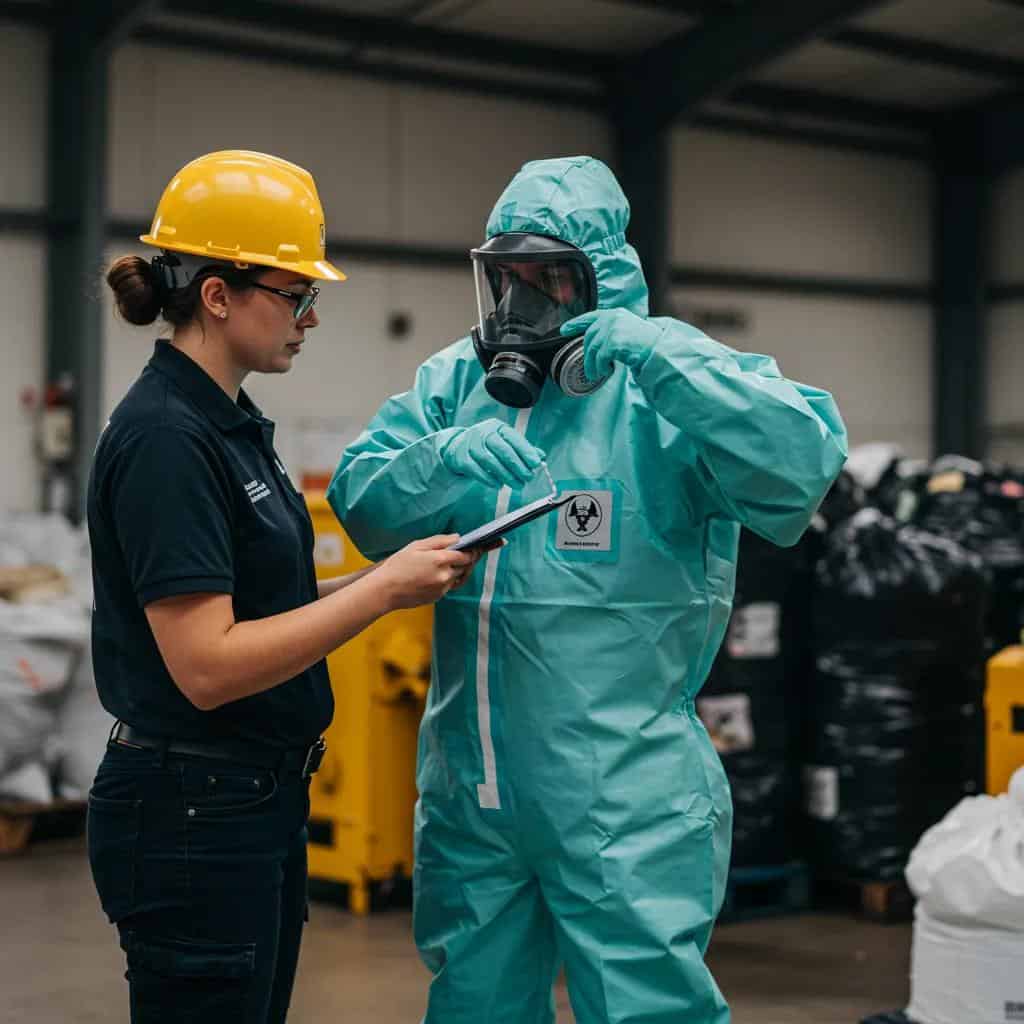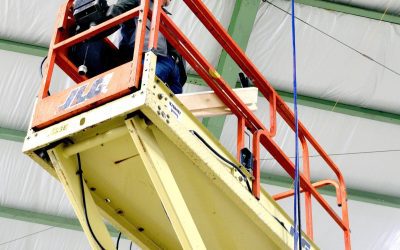HAZWOPER Training for Aerial Lift Operators: 8-Hour vs. 40-Hour OSHA Guide
Do Aerial Lift Operators Need 8-Hour or 40-Hour HAZWOPER Training?
Understanding OSHA Compliance for Lift Work in Hazardous Waste Zones
Why This Matters for Aerial Lift Operators
If you’re using a boom lift, scissor lift, or any mobile elevated work platform (MEWP) near hazardous materials or chemical storage, OSHA might require you to complete HAZWOPER training.
Choosing the right training, 8-hour refresher or 40-hour full course—matters for safety and compliance. This guide explains the differences and helps aerial lift operators and their employers know which one is required under OSHA 29 CFR 1910.120.
What Is HAZWOPER?
HAZWOPER stands for Hazardous Waste Operations and Emergency Response. It’s an OSHA regulation designed to protect workers who:
- Work in hazardous waste cleanup
- Operate at treatment, storage, or disposal facilities (TSDs)
- Respond to spills, leaks, or emergencies involving dangerous substances
Aerial lift operators are often elevated above or inside hazardous zones, putting them at risk—even if they don’t directly handle the materials.
Comparing the 8-Hour and 40-Hour HAZWOPER Training
If you’re new to working around hazardous materials or waste sites, you’ll need the 40-hour HAZWOPER course.
If you’ve already completed that, you’re required to take the 8-hour refresher every year to keep your certification valid.
What’s in the 40-Hour Training?
This training helps aerial lift operators understand:
- Chemical exposure risks from above-ground positions
- How to use PPE (Levels A–D) in high-exposure environments
- How to detect air hazards while elevated
- How to decontaminate themselves and their equipment
- How to respond safely during a chemical release
This course builds a strong safety foundation for operators who work in or near contaminated zones.
What’s in the 8-Hour Refresher?
The refresher course keeps certified workers up to date. It includes:
- New OSHA or EPA regulation changes
- Advances in PPE technology and materials
- Updated emergency communication protocols
- Refreshed decontamination steps and rescue plans
- Real-world case studies and lessons learned
It’s required every 12 months for all HAZWOPER-certified workers.
OSHA Standards That Apply to Aerial Lift Operators
You may already follow OSHA 1926.453 or ANSI A92.22 for lift operation, but 1910.120 (HAZWOPER) applies when you’re exposed to hazardous materials.
According to 1910.120(e)(3):
-
Workers in these areas must take 40 hours of initial training
And under 1910.120(e)(8):
-
All certified workers must take an 8-hour refresher each year
Who Needs the 40-Hour HAZWOPER Training?
Aerial lift operators need the 40-hour course if they:
| Role | Scenario | Training Required |
|---|---|---|
| MEWP Operator at Hazmat Site | Working above tanks, drums, or cleanup areas | 40-Hour + Refresher |
| Lift Operator at TSD Facility | Lifting near chemical transfer or decontamination zones | 40-Hour + Refresher |
| Emergency Response Support | Assisting during a spill cleanup with lift access | 40-Hour + Refresher |
Hands-On Practice Requirement
The 40-hour course includes three days of supervised field work, where lift operators learn:
- How to operate lifts in exclusion or contamination zones
- How to spot vapor clouds, leaks, and unsafe air levels from elevated positions
- How to respond to an incident while working at height
What About the 24-Hour HAZWOPER Course?
This option may apply to aerial lift workers with limited or occasional exposure. It’s shorter than the 40-hour course, but still requires an 8-hour refresher annually.
Course Comparison for Aerial Lift Operators
| Course | Length | Covers | Valid For |
|---|---|---|---|
| 40-Hour Initial Training | 5 days | PPE, chemical hazards, decontamination, response | 1 year |
| 8-Hour Refresher | 1 day | Regulation updates, hazard review, case studies | Repeat yearly |
Choosing the Right Training
To decide which course your team needs, consider:
- Job tasks – Are lifts used for maintenance, access, or emergency cleanup?
- Exposure frequency – How often are workers near chemical or hazardous waste areas?
- Work location – Is the job site regulated under HAZWOPER rules?
Tracking and Documentation
Employers should:
- Keep digital training logs and certificates
- Set up automatic reminders for refreshers
- Ensure all aerial lift operators are up to date before dispatching them to hazmat zones
Why HAZWOPER Matters for Aerial Lift Operators
40-Hour Training:
- Helps workers recognize vapor clouds and unsafe areas from above
- Teaches PPE use during elevated work
- Builds emergency readiness in chemical environments
8-Hour Refresher:
- Keeps up with new safety protocols
- Reinforces hazard detection and communication
- Reduces risk of exposure, injuries, and violations
What If Training Is Skipped?
- Higher injury risk, especially from unknown exposure
- OSHA fines (up to $15,000 per violation)
- Certification loss and project shutdown
- Poor audit results and damaged reputation
Getting Certified
You can take training in these formats:
| Format | What’s Included |
|---|---|
| Online | Self-paced modules, quizzes, simulations |
| In-Person | On-site PPE and emergency practice |
| Hybrid | Mix of online theory and local field drills |
Make sure your training provider issues a certificate after the final assessment.
Choosing a Training Provider
Look for providers that are:
- OSHA-compliant
- Experienced with elevated work and hazardous sites
- Able to provide hands-on PPE and site safety practice
Frequently Asked Questions for Aerial Lift Operators
Do aerial lift operators need HAZWOPER training?
Yes—if you’re using a boom lift, scissor lift, or MEWP near hazardous waste or chemical spills, OSHA may require you to complete HAZWOPER training under 29 CFR 1910.120. The required training depends on your exposure risk and the tasks you perform on-site.
How do I know if I need the 40-hour or 8-hour course?
If you’re new to working in hazardous areas, you’ll need the 40-hour HAZWOPER training, plus three days of field practice.
If you’ve already completed that, you must take the 8-hour refresher course every 12 months to stay certified.
What if I only use lifts occasionally on hazardous sites?
You may qualify for the 24-hour HAZWOPER training if your exposure is limited. However, this still requires the 8-hour annual refresher. Employers must assess your role to determine the correct level of training.
Can aerial lift operators take HAZWOPER training online?
Yes—many accredited providers offer online or hybrid HAZWOPER courses. The 8-hour refresher can be fully online. The 40-hour course may include online theory, but hands-on fieldwork is still required.
What happens if I skip my refresher training?
Skipping your annual 8-hour refresher makes your certification invalid. You could be pulled off hazardous work, and your employer could face OSHA fines for non-compliance.
Do employers need to track training for lift operators?
Yes. Employers are responsible for:
- Keeping training records and certificates
- Scheduling refresher courses before expiration
- Ensuring operators are certified before working in hazmat zones
This helps pass audits and avoids legal trouble if an incident occurs.
Can HAZWOPER training protect me in an emergency?
Absolutely. HAZWOPER training teaches you:
- How to use your PPE correctly
- How to recognize chemical hazards from elevated positions
- What to do during a spill, vapor release, or evacuation
This knowledge can save your life and others on site.
Frequently Asked Questions for Aerial Lift Operators
Do aerial lift operators need HAZWOPER training?
Yes—if you’re using a boom lift, scissor lift, or MEWP near hazardous waste or chemical spills, OSHA may require you to complete HAZWOPER training under 29 CFR 1910.120. The required training depends on your exposure risk and the tasks you perform on-site.
How do I know if I need the 40-hour or 8-hour course?
If you’re new to working in hazardous areas, you’ll need the 40-hour HAZWOPER training, plus three days of field practice.
If you’ve already completed that, you must take the 8-hour refresher course every 12 months to stay certified.
What if I only use lifts occasionally on hazardous sites?
You may qualify for the 24-hour HAZWOPER training if your exposure is limited. However, this still requires the 8-hour annual refresher. Employers must assess your role to determine the correct level of training.
Can aerial lift operators take HAZWOPER training online?
Yes—many accredited providers offer online or hybrid HAZWOPER courses. The 8-hour refresher can be fully online. The 40-hour course may include online theory, but hands-on fieldwork is still required.
What happens if I skip my refresher training?
Skipping your annual 8-hour refresher makes your certification invalid. You could be pulled off hazardous work, and your employer could face OSHA fines for non-compliance.
Do employers need to track training for lift operators?
Yes. Employers are responsible for:
- Keeping training records and certificates
- Scheduling refresher courses before expiration
- Ensuring operators are certified before working in hazmat zones
This helps pass audits and avoids legal trouble if an incident occurs.

